There is a lot of talk about Strategic Human Resource Management these days in Human Resource Management circles, and many pricey books can be found on bookstore shelves. But what is SHRM (Strategic Human Resource Development), what are its major characteristics, and how does it vary from typical HR management?
Strategic human resource management, or SHRM, is a sub-discipline of human resource management, or HRM. It's a relatively recent discipline that arose from the parent discipline of human resource management. Much of the early or so called traditional HRM literature treated strategy as a purely operational issue with consequences that cascaded down across the organisation. There was an unspoken boundary between HR's people-centred ideals and the tougher economic values that belonged to corporate strategies. HR professionals felt uneasy in the war cabinet-like environment where company strategies were developed.
Related: Career in Human Resource Management: Training and Online Courses

Definition of SHRM
The integration of human resources with strategic goals and objectives in order to improve business performance and establish an organisational culture that fosters innovation, adaptability, and competitive advantage is known as strategic human resource management. Accepting and engaging HR as a strategic partner in the creation and implementation of company strategies through HR activities such as hiring, selecting, training, and rewarding employees is what SHRM has to say in the organization.
Strategic human resource management is, in essence, a more focused approach to people management. It is a proactive management paradigm that defines the functions of Human Resource Management (HRM) so that they are specific to the firm where they are implemented. All of this works together to assist the firm by establishing a framework that allows it to achieve its objectives through optimised human resource procedures - the people behind the brand.
A corporation gains the ability to successfully manage its personnel by implementing HRM techniques. SHRM, or strategic human resource management, is concentrated on recognising people as a firm's human resources and thereby bringing value to the company. Human resources are invested to the point that they become assets on an individual as well as a collective level.
Related: What is the Training and Development in HRM?
How does SHRM differ from HRM?
In the last two decades, there has been a growing recognition that HR operations are like islands unto themselves, with softer people-centred principles far removed from the harsh reality of real business. HR functions are required to be perceived as more intimately associated with the strategy and day-to-day operations of the business side of the organisation in order to justify their own existence. Many writers began calling for a more strategic approach to people management in the late 1980s, rather than the typical practises of traditional people management or industrial relations models.
Human resource programmes with long-term goals are the subject of strategic human resource management. Instead of focusing on internal human resource concerns, the focus is on identifying and resolving challenges that have a long-term and often worldwide impact on people management programmes. As a result, the main purpose of human resources is to increase employee productivity by focusing on business challenges that occur outside of human resources.
Key responsibilities of a strategic human resource manager include identifying key HR areas where long-term measures can be taken to improve staff motivation and productivity. Communication between HR and the company's top management is critical since cooperation is impossible without active engagement.
Related: What are Human Resource Development and its importance?
Aspects of Strategies in HRM
- Putting the employees at the centre of every strategy, policy, and process while being true to the company's aims and objectives.
- Creating performance incentive techniques as a motivational tool.
- Conducting individual needs analyses and career assessments to ensure that the appropriate training and development opportunities are available.
- Continuously and holistically focusing on staff development.
- Using well-thought-out tactics to connect the company's requirements and goals with the needs of employees, results in a mutually beneficial partnership.
- Providing people with the skills and abilities they need to grow personally and professionally in ways that benefit both them and the firm.
Key Features of Strategic Human Resource Management
SHRM's main characteristics are as follows:
- There is a clear link between HR policy and practices and the overall strategic goals and environment of the firm.
- There is some sort of organisational structure that connects individual HR interventions so that they are mutually beneficial.
- A lot of the responsibility for human resource management is passed down the line.
Trends in Strategic Human Resource Management
In the context of global digitization, HR practitioners are increasingly confronted with concerns such as employee involvement, human resource flow, performance management, reward systems, and high commitment work systems. Older solutions and recipes that worked in a local setting don't work in a global setting. Cross-cultural issues play a significant role in this. In the first decade of the 21st century, HR professionals and top management working in SHRM are coping with the following main issues:
Related: How Human Resource Planning Is Important For An Organization?
- Market integration's internationalisation.
- Increased competition, which might be local or even nationwide, as a result of free-market philosophy.
- Technological advancements are at a breakneck pace.
- Line and general management principles that are new.
- Changing ownership and, as a result, corporate climates.
- Issues of cross-cultural communication.
- A transfer of economic power from 'developed' to 'developing' countries
SHRM also reflects some of the most pressing issues confronting Human Resource Management today, including HR alignment with core company strategy, demographic trends in employment and the labour market, soft skills integration in an HR department, and knowledge management.
Advantages of Implementing Strategic Human Resource Management
The most significant benefit of SHRM is that procedures are optimised to the point where systems work seamlessly and every cog in the machine contributes to the company's overall commercial success.
It enables for further improvements in areas such as recruiting & selection, interview techniques, training programmes, discipline, incentive systems, performance management, and the like by tailoring strategies, particularly toward company goals and objectives.
Employees are more motivated as a result of the increased focus on them, which leads to increased productivity. Employees feel more valued, and as a result, develop a sense of loyalty and a strong work ethic.
Related: Difference Between Human Resource and Human Capital
The happier the employees are as a result of SHRM, the higher the company's employee retention rate. Companies save time and money by retaining skilled employees, saving hundreds of thousands of rands in recruiting, selection, training, and mentorship of new employees.
Strategic planning implies that circumstances may be anticipated and effectively planned for. A good illustration of this is succession planning. When one or more employees are groomed for a certain position, no time is wasted on training and coaching, and the individual may step in and start working efficiently when the position becomes available.
As a result, SHRM takes the fundamental duties of human resource management and refines them even further. Any company that wants to build a mutually beneficial relationship with its employees must use strategic human resource management.
For Human Resource, Payroll and many more HR Services, visit our website https://lingueeglobal.com/



